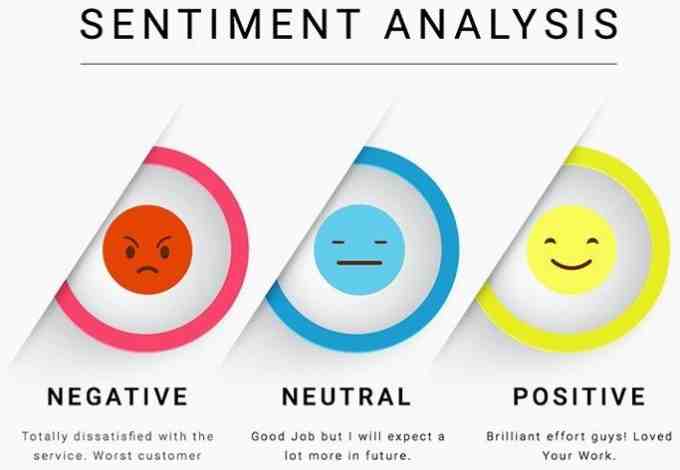Like they say knowledge is power, and utilizing information from customer reviews can help reshape your business or idea. The objective of sentiment analysis is to enable business owners to evaluate the emotional context of their review. You can use sentiment analysis tool to automate your work making everything easier to analyze. You can also use python as a sentiment analysis tool. In this article, there are sentiment analysis examples and projects you can use to better understand what it is all about.
What Is Sentiment Analysis?
Sentiment analysis is also known as opinion mining. It is a method that integrates computational linguistics, biometrics, natural language processing, and text analysis to systematically identify, extract, measure, and evaluate affective states and subjective data.
Sentiment analysis is a common method used by organizations to identify and group ideas regarding a certain good, service, or concept. The concept of sentiment analysis is mining text and subjective information using data mining, machine learning, and artificial intelligence (AI).
How Does Sentiment Analysis work?
Sentiment analysis assists businesses in extracting information from unstructured, unorganized language found in online sources like emails, blog posts, support tickets, web chats, social media channels, forums, and comments. Sentiment algorithms use rule-based, automatic, or hybrid techniques to replace manual data processing.
There are two techniques sentiment analysis uses
- Automatic systems use machine learning to collect information and data.
- Rule-based systems execute sentiment analysis using predetermined, lexicon-based rules.
Combining the two methods results in a hybrid sentiment analysis. Opinion mining can extract the subject, opinion holder, and polarity (or the degree of positivity and negative) from the text in addition to identifying sentiment. Moreover, other scopes, including document, paragraph, sentence, and sub-sentence levels, can be used for sentiment analysis.
Many popular brands uses sentiment analysis to improve their product. Using these tool allows businesses to evaluate client input more frequently and react proactively to market shifts in opinion.
Application of Sentiment Analysis
Organizations can employ sentiment analysis technologies for several purposes, such as:
- Identifying the demographics or target market.
- Obtaining customer input through websites, online forms, or social media.
- Carrying out market analysis.
- Customer service requests into categories.
- Determining brand popularity, reputation, and awareness at a particular period or over time.
- Monitoring consumer response to new improvements or products.
- Determining the effectiveness of a marketing effort.
Sentiment Analysis Example
Sentiment analysis can be used in different part of marking. Examples include
- Brand monitoring
- Customer support analysis
- Customer feedback analysis
- Market research
These are some examples to help you comprehend the objective and difficulties of sentiment analysis:
For instance, a tweet on a new movie Netflix recently release includes comments like
- This is the best movie Netflix has created
- It was not too bad
- I expected better from Netflix
If you notice there are statements regarding the new movie releases but they don’t all mean the same. Sentiment analysis helps to define the content and meaning behind every text or statement. After passing through sentiment analysis, it identifies which one is positive or negative.
- This is the best movie Netflix has created-positive
- It was not too bad- in between/neutral
- I expected better from Netflix-negative.
Knowing how people feel about your product or service will help you improve your brand making it better.
Sentiment Analysis Tool
To make analysing easier, there is a sentiment analysis tool you can use to gather the right information. Sentiment analysis tool will examine the feelings and context of each message. The sentiment analysis data is a gold mine of information for:
- For your customer care teams
- Product development teams
- Marketing teams
To even begin with sentiment analysis back then, you had to examine hundreds of comments, blogs, and survey results. However, you can now automate the process and provide your team with the information they need to succeed by using one of the many sentiment analysis tools available. Your media monitoring project should include sentiment analysis as a core component.
Companies employ sentiment analysis tool for a variety of purposes, including:
- Text analysis
- Review and feedback analytics
- Media tracking
- Social observation
- Complete brand monitoring
The cost of opinion mining tools is typically high. Fortunately, we were able to put together a thorough list of sentiment analysis businesses. Both free and more sophisticated, commercial pieces of software are available for sentiment analysis.
#1. SentiStrength
Sentistrength is a sentiment analysis tool that can automatically analyzes up to 16,000 social web texts every second with human-level accuracy for English.
Unlike the other programs on the list, it is downloaded software that works with Crossover on Mac, Linux, and Android devices in addition to Windows. A web-based demo of the tool is also available. It offers human-level accuracy for the vast majority of English-language web texts.
#2. Social Searcher
Similar to Social Mention on steroids, Social Searcher looks like this. Social searcher offers several features including Social Buzz, Google Social Search, Media Monitoring, etc.
Although you can use it without signing up, there are clear advantages to doing so. You have the option of staying on the free plan or choosing one of the other three, which range in price from 3,49 to 19,49 Euro each month.
#3. Social Mention
Social Mention is a free social media search engine that gathers user-generated content from various social media platforms. The tool gathers information from websites like Reddit, Flickr, or Google News. It also provides sentiment analysis for Twitter.
The platform follows the data from its website and keeps an eye on more than 100 social media sites. Although it’s nice that you may start monitoring a topic or brand without creating an account, you won’t be able to remember your results for later.
Even so, for those just getting started with social media monitoring, it offers useful information given that it is a free sentiment analysis tool.
#4. Hi-Tech BPO
Hitech is a sophisticated sentiment analysis tool that offers services including data processing, market intelligence, analytics, and sentiment analysis. They take great pride in deciphering the meaning behind product and service reviews that are presented in text, audio, emoji, photos, and other visual mediums.
They categorize sentiment analysis into four groups:
- Opinion mining focuses on determining the polarity of an opinion.
- Mining text
- Social listening
- Sentiment Analysis
#5. Brand24
Sentiment analysis is only one of the tools available in Brand24, which is fundamentally a media monitoring tool that you can utilize to your benefit. Web and social media monitoring is available from Brand24. The application covers all significant blogs, forums, news websites, podcasts, and newsletters in addition to key social media networks.
All gathered mentions and social media posts are subject to a sentiment analysis algorithm. Brand24 offers sophisticated media monitoring analytics and collects mentions in real-time across news sites, podcasts, blogs, forums, and social media platforms like Facebook, Twitter, Instagram, YouTube, and Twitch. It is one of the greatest sentiment analysis tools available because of this.
You may track your brand online and ascertain brand sentiment with the use of sentiment analysis.
It can be used in any of the tool’s dashboard tabs. Real-time text data analysis is done by Brand24 using machine learning algorithms and natural language processing.
Sentiment Analysis Project
You can create a unique strategy of your own to evaluate the sentiment analysis project. One of the sentiment analysis projects you can do:
Amazon Product Reviews
The first beginner-friendly Sentiment Analysis project idea is about evaluating Amazon product reviews. Amazon is one of the biggest e-commerce stores, and it also has a wide product selection. When companies want to understand public opinion, performing sentiment analysis helps them recognize what customers like about their products. It also helps to figure out the primary issues with their products.
There are various ways to access text for sentiment analysis:
- You may use scraping to look up opinions and sentiments about your business, goods, or services on Twitter, Facebook, and Instagram. Frequently written blogs and review articles can also be helpful.
- Any correspondence with your customers via emails, texts, or forms for complaints or feedback can be helpful for gathering input on your products and adjusting marketing efforts.
- To learn more about what people think of your company, you can scrape sources like newspapers and internet discussion boards.
- These methods can assist you in assessing your market position and client demographics, such as age and gender, so you can identify your target market and the people you should concentrate your marketing efforts on.
- Scraping information from influencers’ profiles to see what they and their followers have to say about your products is another approach to observing how buyers are responding. According to research, 81% of consumers polled purchased a product after clicking on an influencer’s link.
Python Sentiment Analysis
Python sentiment analysis is a way for examining text to find the sentiment that is concealed therein. Combining machine learning and natural language processing allows it to achieve this (NLP). With sentiment analysis, you can look at the emotions portrayed in a text. Python sentiment analysis uses python as a code to analyze.
If not, then you probably already know about Python, which is a strong programming language with an easy-to-understand syntax. Not to mention that it’s a well-liked option in the data science field, making it ideal for our tutorial.
Why Sentiment Analysis Is Important For Your Business
For businesses to make better decisions, address market pain points, and monitor customer behavior in real-time to best understand their emotional commitment to a brand or product, sentiment analysis is vital. Also, it is quite efficient for scaling big volumes of data, such as when examining the sentiment of thousands of tweets to see how people are reacting to the debut of a new product.
This enables a quicker response to urgent problems and the detection of problems that would have escaped notice during the testing phase. As a result, marketers are better able to comprehend their target market and come up with inventive approaches to effectively reach them. Because existing users are happier with the service, brand loyalty rises and customer churn rates decline dramatically as a result. By attracting new customers, improved customer experience can even grow the consumer base of the business.
READ ALSO CUSTOMER FOCUS
Is Sentiment Analysis AI or ML?
It uses machine learning (ML), natural language processing (NLP), data mining, and artificial intelligence (AI) tools to mine, extract, and categorize consumer opinions about a company, product, person, service, event, or concept.
What Is the Aim of Sentiment Analysis?
The goal of sentiment analysis is to precisely extract people’s thoughts from numerous unstructured review texts and categorize them into sentiment classes, such as positive, negative, or neutral sentiment. Both “very favorable” and “extremely negative” are occasionally taken into consideration.
What Is the Best Tool for Sentiment Analysis?
MonkeyLearn is one of the best tools for sentiment analysis. It offers a variety of very accurate text analysis tools, including one that is ready for use that analyzes sentiment.
MonkeyLearn is an easy-to-integrate tool. You can integrate sentiment analysis tools into your stack using the MonkeyLearn API if you know how to code.
You may also teach it to recognize industry-specific lingo and define each degree of sentiment about your business by utilizing your business data and criteria during the training process.
MonkeyLearn functions in three ways and that is:
- Data Import
- Sentiment analysis model training
- Process automation
What Are the Four Main Steps of Sentiment Analysis?
#1. Data Collection
The sentiment analysis procedure includes this as one of the most crucial elements. The quality of the data that has been acquired and how it has been annotated or labeled will determine everything that comes after this.
There are two ways of collecting data and it includes
- API Data
- Manual
#2. Data Processing
The type of information in the data—text, image, video, or audio—will determine how it is processed.
transcription of audio
- Caption augmentation
- Picture augmentation
- Logo identification
- Extraction of text
#3. Data Analysis
To complete this level of the sentiment analysis process, numerous smaller jobs must be completed.
- Modifying the model
- Data that is multilingual
- Unique Tags
- Classification of Topics
- Sentiment Assessment
#4. Data Visualization
Following the completion of each step in the sentiment analysis process, the insights are immediately transformed into reports that may be used for action in the form of graphs and charts. Then, these reports can be distributed throughout teams. Because you may view specific, aspect-based results through these visual reports, they are quite significant.
What Is a Real-life Example of Sentiment Analysis?
You can use sentiment analysis in market research
A brand-new manufacturer of healthy snacks wanted to have a clear image of its commercial potential in the market it was trying to break into. They were interested in knowing not only what people typically ate for snacks, but also what sprang to mind when they heard the phrase. There was no pre-made list of snack brand names that could be scratched off because the questions were open-ended to ensure that the survey was as objective as possible.
Sentiment analysis API was able to quickly data mine all of the open-ended questions with hundreds of replies and provide insightful results.
It not only provided an average of which food brands were referenced most frequently, but it also identified the rivals of the new business. Knowing this information helped the new entrant to make particular decisions about the roll-out of its product and which market niches to target since knowledge is power.
In Conclusion,
Sentiment analysis is the process of identifying positive or negative sentiments in text. Businesses frequently employ it to analyze social media data for sentiment, evaluate brand repute, and comprehend clientele.
FAQs
What are the three approaches of sentiment analysis?
There are various approaches to sentiment analysis
- Naive Bayes
- Deep Learning LSTM
- Pre-Trained Rule-Based VADER Models.
What are the three types of sentiment analysis?
Sentiment analysis can be classified as
- Knowledge-based
- Statistical
- Hybrid.
What is sentiment alogorithm
Sentiment algorithm is specifically designed to examine the emotional tone of social media posts like tweets and status updates.
Related Articles
- BRAND MONITORING: Definition and Detailed Guide)
- MEDIA MONITORING: Top Media Monitoring Tools In 2023
- AI Marketing: Top 30+ Artificial Intelligence Marketing Tools
- 11 BEST BUSINESS TEXT MESSAGING SERVICE & REVIEWS
- Mining Bitcoin and Expanding Your Wallet






